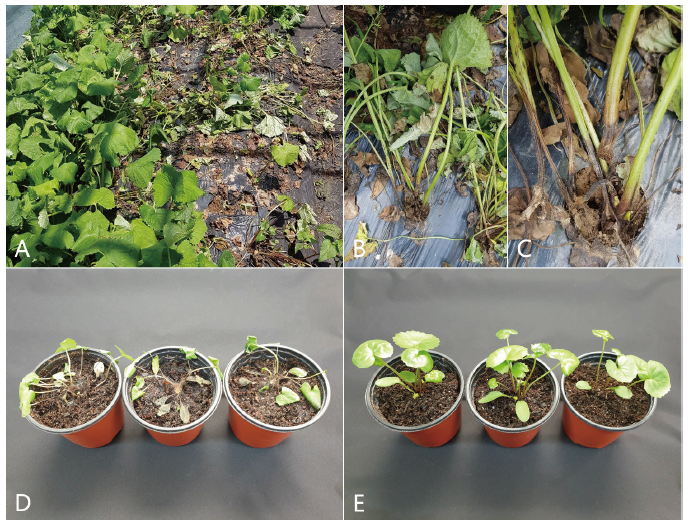Fischer’s ragwort [Ligularia fischeri (Ledeb.) Turcz.] is a perennial plant belonging to family Asteraceae. The plant is widely distributed in Northeast Asia and is native to the mountainous areas. The plant is grown as a wild vegetable in Korea, and Korean farmers generally grow the plant in vinyl greenhouses. In July 2019, damping-off symptoms of young Fischer’s ragwort plants were observed in four vinyl greenhouses of a farmer located in Taebaek, Gangwon Province, Korea. The symptoms initially appeared on the petioles of the plants at the soil line. The infected parts of the plants turned brown or dark brown, softened, and rotted. Diseased plants wilted and later blighted (Fig. 1A-1C). Three sites were observed in a vinyl greenhouse, and one hundred plants at each site were investigated for the incidence of the disease. The disease occurred among 20-30% of plants in the four vinyl greenhouses investigated.
Rhizoctonia sp. was isolated from plants of Fischer’s ragwort that displayed damping-off symptoms, using the method described in a previous study [1]. Lesion pieces measuring 3 mm to 5 mm were cut from the petioles of the diseased plants, surface-sterilized with 1% sodium hypochlorite solution for one minute, and plated on 2% water agar (WA). The fungal mycelia growing from the lesions were transferred to potato dextrose agar (PDA) slants after incubating the plates at 25℃ for 1-2 days. Nine isolates of Rhizoctonia sp. were obtained from the lesions of the diseased plants and identified as R. solani Kühn, based on the morphological characteristics described in previous studies [2,3].
The isolates were tested for anastomosis grouping using tester isolates of R. solani, as previously described [1]. The tester isolates of R. solani (AG-1 through AG-5) used were identical to those used in a previous study [4]. All the tested isolates were classified as R. solani AG-2-2. Anastomosis reactions between the tested isolate and the tester isolate of R. solani AG-2-2 are shown in Fig. 2A. Mycelia of the isolates cultured on PDA were brown to dark brown in color, and the colony displayed concentric zones (Fig. 2B). Sclerotia, which are dark brown, woolly, and spherical to irregular in shape, were absent or rarely formed on the medium. The cultural type of the isolates was identified as ⅢB of R. solani AG-2-2, based on the cultural characteristics described in a previous study [5].
Three isolates of R. solani AG-2-2 (ⅢB) were tested for pathogenicity on Fischer’s ragwort using artificial inoculation, as previously described [6]. Mycelial disks of 6 mm in diameter, from each isolate grown on PDA, were placed on petioles at the soil surface level of 4-month-old Fischer’s ragwort plants that were grown in circular plastic pots (height: 9 cm; upper diameter: 10 cm; lower diameter: 7 cm) in a vinyl greenhouse. Inoculated plant pots were placed in plastic boxes (60 cm×43 cm×33 cm) with a relative humidity of 100% at room temperature (24-26℃) for 4 days. Thereafter, the inoculated plant pots were removed from the boxes and kept indoors at room temperature. The pathogenicity of the isolates was investigated 5 days after inoculation. The inoculation test was performed in triplicate.
Pathogenicity of the three isolates on the plants was confirmed with the inoculation tests (Fig. 1D), which showed damping-off symptoms similar to those observed in the diseased plants in the vinyl greenhouses investigated. No symptoms were observed in the control plants (Fig. 1E). The inoculated isolates were re-isolated from the lesions.
R. solani causes damping-off in various crops [6-8]. It has been reported that anastomosis groups of R. solani have different genetic and pathological characteristics [3].
Damping-off of Fischer’s ragwort caused by R. solani is recorded only in the list of plant diseases in Korea [9]; however, there has been no description on the disease incidence and identification of the pathogen elsewhere. In addition, anastomosis groups and pathogenicity of R. solani isolates from Fischer’s ragwort have not been previously reported. However, it has been reported that R. solani AG-2-2 (ⅢB) causes root and stem rot, sheath blight, damping-off, and petiole rot in the host crops in Korea [6]. This is the first report of R. solani AG-2-2 (ⅢB) causing damping-off in Fischer’s ragwort.

Fig. 2. Anastomosis test of Rhizoctonia solani isolate from Fischer's ragwort and cultural appearance of the isolate. A: Anastomosis reactions between the tested isolate (left) and the tester isolate (right) of R. solani AG-2-2 (ⅢB) observed by light microscope. The arrows indicate points of hyphal anastomosis. B: A colony of R. solani AG-2-2 (ⅢB) isolate grown on potato dextrose agar at 25℃ for 12 days.



